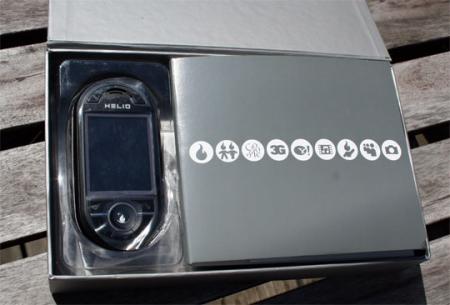
The Helio Ocean marks a sea change in the evolution of MVNOs. Previously allotted for a limited demographic, the Ocean signals a significant market expansion for the cellco youngster Helio. Aimed directly at the Sidekick crowd, the Ocean could be poised to erode some of T-Mobile’s bountiful cache of hip youngsters with cash to liquidate for cool technologies.
Since it announced the Ocean back in March, Helio has been floating pretty on the buzz created by the new $295 device. It was a good position be in, but now with the device nearly released, it’s time to defuse the buzz and see how the device performs.
The Ocean washed up on our doorstep yesterday and I’ve been wading through it over the past 24 hours. Here are my thoughts:
The Ocean incorporates a two-way sliding mechanism that gives the devices the powers of both a phone keypad and a full QWERTY keyboard. The combination of the two adds to the device depth and mass that surpasses that of most typical phones. It’s not obtrusive or anything, it just has a healthy weight to it.
Its keyboard is the best I’ve yet seen on a device of this nature. The keys are adequately spaced so that even with my giant fingers, I could easily hit just one button. This is a problem I’ve experienced with practically every smartphone I’ve used. Everyone knows I love the Blackjack, but typing on it can be a nuisance due to the crowding on the keyboard. Not so with the Ocean. Well done.
From a feature perspective the Ocean holds much in common with its siblings Drift and Heat. The user interface is navigated through a circular design that places your contacts at the center (perhaps indicating that connecting people is at the center of this heliocentric universe). Notable amongst the features that carry over from previous Helio devices is its GPS functionality — a charge that Helio is leading strongly. And it runs quicker and better in the Ocean than in any of Helio’s previous devices.
GPS in phones is a brilliant addition. As the technology proliferates more widely, things like buddy beacons are going to become excellent methods of communication. Imagine being able to see where all of your friends are on a Saturday night. Furthermore, I expect locational comments to develop soon where people can leave messages pinned to specific GPS coordinates to communicate with future passersby. Cool stuff. I should also note that you can turn your beacon off so as to avoid any sort of Big Brother monitoring.
Many have complained that the Ocean lacks WiFi, but I find this to largely be a blank concern. Sure WiFi is fast, but EV-DO is more than passable for a device of this nature. Helio functions on the Sprint network and, as always, Sprint works well for wireless broadband.
It comes ready to support Yahoo! Messenger and AIM as well as Gmail and Windows Live email. Users can also setup additional email accounts quickly so that they’re never out of touch. It’s a dangerous road to venture down, but it’s a path we’re on for better or worse.
The main comparison here is going to be with the Sidekick. Danger has managed to wield a considerable crowd through the implementation of simple, yet feature rich, UI. The Sidekick is also about the size of my cat — and about as practical in a pocket. The Ocean is considerably smaller yet it still maintains all of the core features of the Sidekick and it manages to contribute a few of its own to the fray (like GPS).
I’ve never been a fan of the Sidekick because of its size, but I’m surrounded by people who adore it. I see in the Ocean what they’ve seen all along in the Sidekick. It’s a widely functional media device with massive hipster appeal. There is something decidedly cool about whipping it out in public and having people ogle from across the room. The experience is made even cooler by the fact that the device works immensely well — well enough that it’s just become my new personal phone.